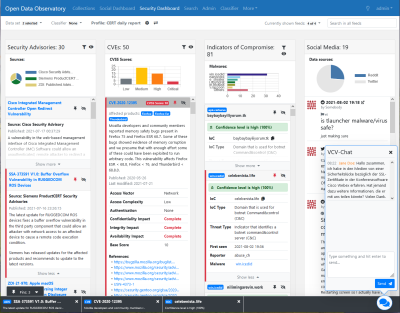We curated a list of this year’s publications — including links to social media, lab websites, and supplemental material. We have 58 full papers, 13 LBWs, one DC paper, and one Student Game Competition, and we lead five workshops. Two papers were awarded a best paper award, and four papers received an honourable mention.
Is your publication missing? Send us an email: contact@germanhci.de
‘We Do Not Have the Capacity to Monitor All Media’: A Design Case Study on Cyber Situational Awareness in Computer Emergency Response Teams
Marc-André Kaufhold (TU Darmstadt), Thea Riebe (TU Darmstadt), Markus Bayer (TU Darmstadt), Christian Reuter (TU Darmstadt)
Abstract | Tags: Best Paper, Full Paper | Links:
@inproceedings{Kaufhold2024DoNot,
title = {‘We Do Not Have the Capacity to Monitor All Media’: A Design Case Study on Cyber Situational Awareness in Computer Emergency Response Teams},
author = {Marc-André Kaufhold (TU Darmstadt), Thea Riebe (TU Darmstadt), Markus Bayer (TU Darmstadt), Christian Reuter (TU Darmstadt)},
url = {www.peasec.de, website},
year = {2024},
date = {2024-05-11},
urldate = {2024-05-11},
abstract = {Computer Emergency Response Teams (CERTs) have been established in the public sector globally to provide advisory, preventive and reactive cybersecurity services for government agencies, citizens, and businesses. Nevertheless, their responsibility of monitoring, analyzing, and communicating cyber threats and security vulnerabilities have become increasingly challenging due to the growing volume and varying quality of information disseminated through public and social channels. Based on a design case study conducted from 2021 to 2023, this paper combines three iterations of expert interviews (N=25), design workshops (N=4) and cognitive walkthroughs (N=25) to design an automated, cross-platform and real-time cybersecurity dashboard. By adopting the notion of cyber situational awareness, the study further extracts user requirements and design heuristics for enhanced threat intelligence and mission awareness in CERTs, discussing the aspects of source integration, data management, customizable visualization, relationship awareness, information assessment, software integration, (inter-)organizational collaboration, and communication of stakeholder warnings.},
keywords = {Best Paper, Full Paper},
pubstate = {published},
tppubtype = {inproceedings}
}

Touching the Moon: Leveraging Passive Haptics, Embodiment and Presence for Operational Assessments in Virtual Reality
Florian Dufresne (Arts et Métiers Institute of Technology), Tommy Nilsson (European Space Agency), Geoffrey Gorisse (Arts et Métiers Institute of Technology), Enrico Guerra (University Duisburg-Essen), André Zenner (Saarland University & DFKI), Olivier Christmann (Arts et Métiers Institute of Technology), Leonie Bensch (Institute for Software Technology - Software for Space Systems, Interactive Visualization), Nikolai Anton Callus (European Space Agency), Aidan Cowley (European Space Agency)
Abstract | Tags: Best Paper, Full Paper | Links:
@inproceedings{Dufresne2024TouchingMoon,
title = {Touching the Moon: Leveraging Passive Haptics, Embodiment and Presence for Operational Assessments in Virtual Reality},
author = {Florian Dufresne (Arts et Métiers Institute of Technology), Tommy Nilsson (European Space Agency), Geoffrey Gorisse (Arts et Métiers Institute of Technology), Enrico Guerra (University Duisburg-Essen), André Zenner (Saarland University & DFKI), Olivier Christmann (Arts et Métiers Institute of Technology), Leonie Bensch (Institute for Software Technology - Software for Space Systems and Interactive Visualization), Nikolai Anton Callus (European Space Agency), Aidan Cowley (European Space Agency)},
url = {https://umtl.cs.uni-saarland.de/, website},
doi = {10.1145/3613904.3642292},
year = {2024},
date = {2024-05-11},
urldate = {2024-05-11},
abstract = {Space agencies are in the process of drawing up carefully thought-out Concepts of Operations (ConOps) for future human missions on the Moon. These are typically assessed and validated through costly and logistically demanding analogue field studies. While interactive simulations in Virtual Reality (VR) offer a comparatively cost-effective alternative, they have faced criticism for lacking the fidelity of real-world deployments. This paper explores the applicability of passive haptic interfaces in bridging the gap between simulated and real-world ConOps assessments. Leveraging passive haptic props (equipment mockup and astronaut gloves), we virtually recreated the Apollo 12 mission procedure and assessed it with experienced astronauts and other space experts. Quantitative and qualitative findings indicate that haptics increased presence and embodiment, thus improving perceived simulation fidelity and validity of user reflections. We conclude by discussing the potential role of passive haptic modalities in facilitating early-stage ConOps assessments for human endeavours on the Moon and beyond.},
keywords = {Best Paper, Full Paper},
pubstate = {published},
tppubtype = {inproceedings}
}
